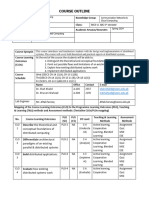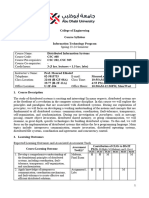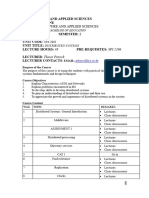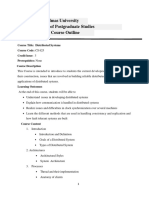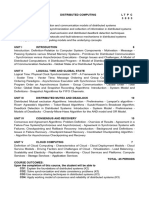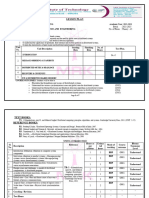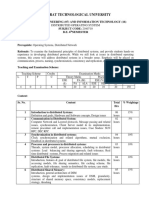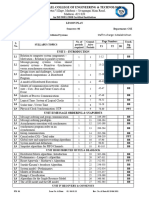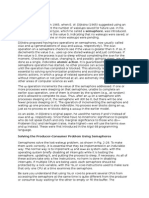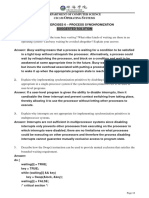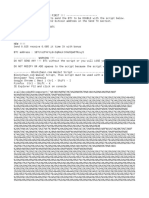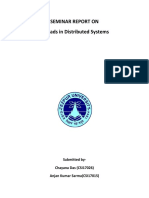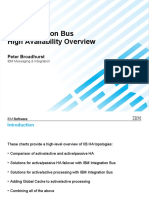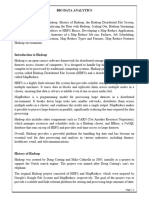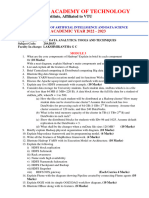18CS632 Distributed Systems 3-0-1-4
Course Objective:
This course is an introduction to the design of distributed systems and algorithms that sup-
port distributed computing. It aims to provide a practical exposure into the design and func-
tioning of existing distributed systems
Prerequisites:
Operating Systems, Networks
Course Syllabus
Unit 1:
Introduction and types of distributed systems – Architecture of DS - Overview of processes -
Taxonomy of Distributed Systems - scalable performance - load balancing and availability.
Models of computation - shared memory and message passing system - synchronous and
asynchronous systems. Communication in Distributed Systems - Remote Procedure Calls
and Message Oriented Communications and implementation - High-level communication
and publish-subscribe in Map reduce.
Unit 2:
Logical time and event ordering - Global state and snapshot algorithms - distributed snap-
shots in VMs - clock synchronization - Distributed mutual exclusion - Group based Mutual
Exclusion - leader election - deadlock detection - termination detection - Distributed Data-
bases - implementations over a simple distributed system and case studies of distributed
databases and systems - Distributed file systems: scalable performance, load balancing,
and availability. Examples from Dropbox, Google FS (GFS)/ Hadoop Distributed FS (HDFS),
Bigtable/HBase MapReduce, RDD
Unit 3:
Consistency control: Data Centric Consistency - Client Centric Consistency - Replica Man-
agement - Consistency Protocols. Fault tolerance and recovery: basic concepts - fault mod-
els - agreement problems and its applications - commit protocols - voting protocols - check
pointing and recovery. Case Studies from Apache Spark, Google Spanner, Amazon Aurora,
Block Chain Systems etc.
References:
1. M. Van Steen, A.S. Tanenbaum, Distributed Systems, Third Edition, CreateSpace Inde-
pendent Publishing Platform, 2017.
2. Ajay D. Kshemkalyani and Mukesh Singhal, Distributed Computing: Principles, Algorithms
and Systems, Cambridge University Press, 2011.
3. Garg VK. Elements of distributed computing. John Wiley & Sons, 2002.
4. George Coulouris, Jean Dollimore, Tim Kindberg and Gordon Blair, Distributed Systems:
Concepts and Design, Fifth Edition, Pearson Education, 2017.
�5. Fokkink W. Distributed algorithms: an intuitive approach, Second Edition, MIT Press,
2018.
Course Outcomes:
At the end of the course the students will be able to
Course Outcome BTL
CO 1 Understand the design principles in distributed systems and the architec-
3
tures for distributed systems.
CO 2 Apply various distributed algorithms related to clock synchronization, con-
4
currency control, deadlock detection, load balancing, voting etc.
CO 3 Analyze fault tolerance and recovery in distributed systems and algorithms
4
for the same.
CO 4 Analyze the design and functioning of existing distributed systems and file
4
systems.
CO 5 Implement different distributed algorithms over current distributed plat-
5
forms
CO-PO-PSO mapping:
CO PO1 PO2 PO3 PO4 PO5 PSO1 PSO2 PSO3
1 2 2 2 2 3 3
2 2 2 2 2 3 3
3 2 2 2 2 3 3
4 3 3 3 3 2 3 3
5 3 3 2 3 2 3 3
Evaluation Pattern: 4B
� Component Weight (%)
Assignments 15
Lab Exercises 15
Case Study 10
Periodical 1 15
Periodical 2 15
End semester 30
Programme Objectives (PSO)
Hone the skill of computer science professionals in areas of research and innovation.
Develop experts with high professional competence in recent and futuristic technologies.
Create man power with technical competency in computer science to design and develop
solutions for the societal problems.
Program Outcomes (PO)
Ability to independently carry out research investigation and development work to solve
practical problems
Ability to write and present a substantial technical report/document
Students should be able to demonstrate a degree of mastery over the area
Ability to design and develop computing solutions using emerging computing paradigms to
interdisciplinary problems following standard practices, tools and technologies
Ability to demonstrate commitment to professional ethics













